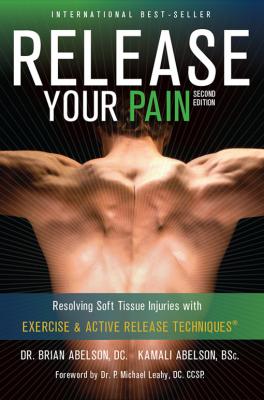ТОП просматриваемых книг сайта:
Release Your Pain: 2nd Edition - EBOOK. Dr. Brian James Abelson DC.
Читать онлайн.Название Release Your Pain: 2nd Edition - EBOOK
Год выпуска 0
isbn 9780987866219
Автор произведения Dr. Brian James Abelson DC.
Жанр Здоровье
Серия Release Your Body
Издательство Ingram
Biomechanical analysis of an action or activity is an essential part of any ART treatment program. Several years ago, Kamali and I were fortunate enough to be involved in the writing of the ART Biomechanics Manual. This 600+ page online help system that we helped to produce is currently used to train practitioners on how to conduct a biomechanical analysis.
ART practitioners certified in Biomechanics can:
Quickly determine which structures are affected along the entire kinetic chain by paying attention to more than just the area of chief complaint.For example, a runner with lateral knee pain will often have accompanying restrictions in their lower extremities (dorsi flexors) and hips (external hip rotators). Even though the runner is not experiencing pain in these areas, it is essential to treat these areas since the dorsi flexors aid in controlling foot drop (eccentric contraction) and are involved in shock absorption by the lower extremities. Restrictions in this area can be a common cause of knee pain. In addition, restrictions in the hip often cause the runner’s leg to rotate out to the side (external rotation) resulting in increased stress on the knee.
Identify the antagonistic structures (opposing muscle groups) to those that have been identified as the primary structures causing the imbalance.Since function and performance is based upon balance and coordination, an opposing soft-tissue structure is always affected by restrictions in the primary structure. These muscle imbalances often lead to injuries. Some examples of primary muscles and their corresponding antagonists are:biceps and triceps.quadriceps and hamstrings.pectoralis and latissimus dorsi.anterior and posterior deltoids.
Once the affected areas (primary structures and their antagonists) have been located, the ART practitioner is able to systematically remove restrictions along the entire kinetic chain. Patients often see immediate improvements in their sports performance; from their running and walking speed, to increased power and accuracy in a golf stroke, to an ability to throw more precisely and at greater speeds.
Conditions That Can Be Helped with ART
ART can help with...
Achilles Tendonitis
Ankle Injuries
Arthritis
Back Pain/ Back Injuries
Bicipital Tendonitis
Bunions and Bursitis
Carpal Tunnel Syndrome
Compartment Syndrome
De Quervain’s Tenosynovitis
Dupuytren’s Contracture
Foot Pain and Injury
Frozen Shoulder or Adhesive Capsulitis
Gait Imbalances
Golfer’s Elbow (Tendonitis)
Golf Injuries
Hammer Toes
Hand Injuries
Headaches
Hip Pain
Iliotibial Band Syndrome
Impingement Syndromes
Joint Dysfunctions
Knee Meniscus Injuries
Knee and Leg Pain
Muscle Pulls or Strains
Muscle Weakness
Myofasciitis
Neck Pain
Nerve Entrapment Syndromes
Plantar Fasciitis
Post-Surgical Restrictions
Repetitive Strain Injuries
Rib Pain
Rotator Cuff Syndrome
Running Injuries
Scar Tissue Formation
Sciatica
Shin Splints
Shoulder Pain
Sports Injuries
Swimmer’s Shoulder
Tendonitis
Tennis Elbow (Tendonitis)
Thoracic Outlet Syndrome
Throwing Injuries
TMJ
Weight- Lifting Injuries
Whiplash
Wrist Injuries
Remodeling Tissues with Exercise
Chapter
5
Phases of Remodeling Soft Tissues
Using Exercise to Remodel Injured Tissue
Exercise is an integral component of all Active Release Techniques treatment protocols. It is the critical element required to ensure both proper tissue remodeling and to restore full neurological function.
Phases of Remodeling Soft Tissues
To better understand why exercise is so essential, let us consider the process of tissue repair after injury. This repair typically occurs over three distinct phases1:
1 - Reaction or Acute Inflammatory phase: This 72hour phase is characterized by swelling and pain. During this phase, use ice to reduce inflammation, and if required, take an over-the-counter anti-inflammatory medication. Avoid using these medications after the first 72 hours since they can have a negative effect on tissue regeneration. Even during this initial stage, it is important to get some motion into the affected area in order to speed the healing process.
2 - Regenerative or Repair phase: During this 48-hour-to-six-week phase, new collagen is formed and laid down to repair the injured area. If the injured person is performing the correct exercises, the majority of the collagen will be laid down in the same direction as the tissue being repaired, making the repaired tissue stronger and more capable of performing its function. If the individual is not exercising, the tissue will be laid down in more random patterns, leading to the development of weaker tissue that is easily re-injured.
3 - Remodeling Phase: The remodeling phase can last up to 12 months. During this phase the collagen fibres increase in size, diameter, and strength. The amount of remodeling that takes place is dependant upon the forces that are applied to the tissue as the collagen remodels to withstand the stresses that are placed upon it. If the injured person is performing appropriate strengthening exercises, the collagen will remodel to withstand the stresses placed upon it. With exercise, this remodeling will lead to a complete recovery of the injured tissue, along with a decreased chance of re-injury. Without appropriate strength training, the possibility of re-injury is very high.
It is very important to exercise throughout all stages of tissue repair. Lack of exercise results in decreased oxygen delivery to soft tissues, increased scar tissue formation, and increased muscle atrophy, and can

